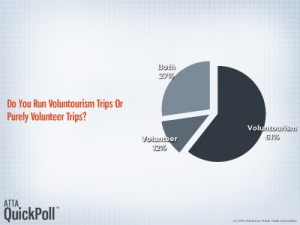
In April 2012 the ATTA undertook a brief, members-only tour operator survey to continue its efforts to analyze trends and shifts in voluntourism, an emerging niche that is often either the focus of or a component to adventure tourism trips. More than 140 members responded. Some key highlights are listed below.
The ATTA made a distinction between volunteer trips (where the main purpose is to engage in volunteer work, and travel takes a secondary or incidental role) and voluntourism trips (where travel plays and equal or greater role to the volunteer component of the trip). Just over 60 of our respondents identified themselves as volunteer operations, and slightly over 12 percent as volunteer, with the remainder identifying as operating both types.
- Fifty-five percent currently run volunteer trips; of the remaining 45 percent, over 41 percent of them are considering them for the future. Reasons cited for this included “growing awareness and demand for ‘giving back’” as well as consumer trends towards local and sustainable initiatives.
- Just over 80 percent of total respondents said that voluntourism or volunteer activities were a component of 25 percent or less than their itineraries, while only 11.34 percent said they were part of 76 percent or more
- Most popular destinations for volunteer itineraries were (in order of popularity) South America, East Africa, India / South Asia, Central America, Southern Africa and Southeast Asia
- ATTA members reported their volunteer travelers to be 53.21 percent female and 46.79 male. Just over 12 percent of these consumers were younger than 20 years old, with 20-40 year-olds and 41-60 year olds coming in at almost 33 percent and 34 percent respectively.
- The most popular types of volunteer projects offered, respectively, were: working with children and education (tied at 15.27 percent each), environmental protection or recovery (13.99 percent), wildlife recovery or habitats and local job creation or economic projects (tied at 10.18 percent each) and clean water projects (at 7.89 percent)
- Other types included working with women (rights or economic projects), food supply, medical projects, disaster rebuilding, permaculture, heritage conservation, land stewardship, construction, trail maintenance, green housing, climate care
- Fifty one of the respondents run their own volunteer / voluntourism project “in-house”, while 44 work directly with external organizations. The remaining ten replied “other”; qualitative answers reveal the respondents are either the organization which provides the program and uses other operators for volunteers, or they do a combination of both practices depending on the market.
- The majority of respondents said the volunteer component of the itinerary was either somewhat important (32.53) or important (30.12) in terms of the client booking the trip. Over 22 percent said it was “very important” and 12 percent said it was extremely important; only 2.41 percent said it was not at all important.
